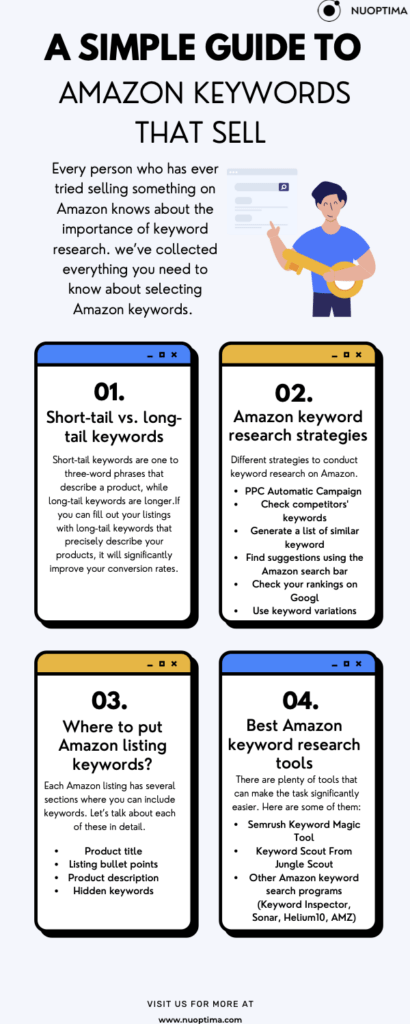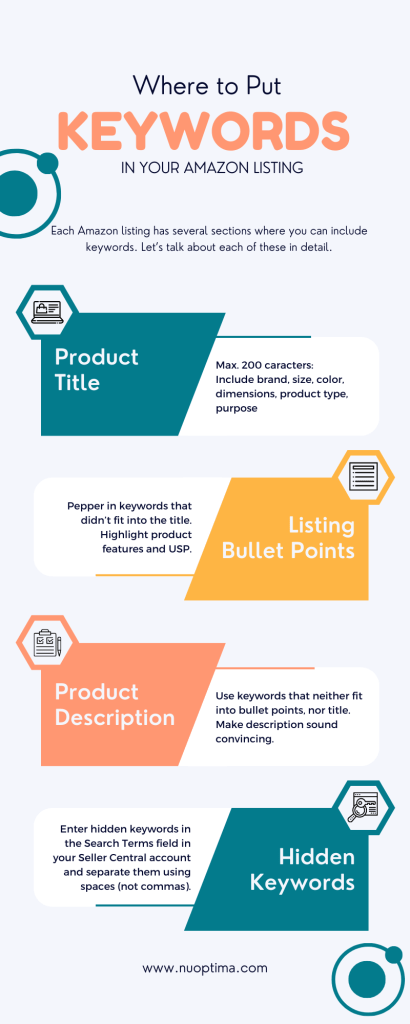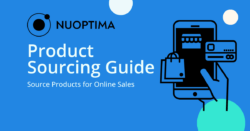Key points
- Amazon analyzes keywords included in all product listings posted on its platform to determine which listings are relevant for different search queries.
- If you want your products to show up in the results for relevant Amazon searches, you need to conduct thorough keyword research and optimize your listings for those keywords.
- Some of the most effective keyword research methods include using automatic PPC campaigns, utilizing keyword research software, using Amazon autocomplete suggestions and keyword variations, getting relevant keywords from Google search results, utilizing complementary products for keyword optimization, etc.
- When optimizing your listings, you can put keywords in the title, description, bullet points, or search terms.
Every person who has ever tried selling something on Amazon knows about the importance of keyword research. After all, having all the right keywords in your Amazon listings is one of the keys to increasing your sales and making a profit on Amazon. But if you’ve never done it before, keyword research can seem complicated and confusing. This is why we’ve collected everything you need to know about selecting Amazon keywords in this article.
Amazon A9 search engine

As you know, Amazon is not a search engine like Google or Yahoo; it is an online marketplace where people can see and buy products. So naturally, Amazon’s goal is to sell as many products as possible to collect fees from sellers and make their platform even more attractive to new buyers and sellers. Amazon can maximize sales on its platform by ensuring that whenever a user enters a string of keywords in the search bar on Amazon, the results they see match what they were looking for as closely as possible.
The logic behind this is simple. Let’s say you’re searching for women’s Chelsea shoes on a thick sole. You go to Amazon to search for these shoes and scroll through several pages of results without seeing a product that suits your needs. In this case, there’s a considerable chance that you will leave Amazon and go to Macy’s, Nordstorm, or another website to search for the shoes you like. However, if Amazon shows you several products that closely match your preferences, you will be a lot more likely to purchase one of those products right away.
This brings us to the key characteristic Amazon A9 search algorithm takes into account when selecting which products to show at the top of search results – relevance. Of course, the algorithm also looks at the listings’ conversion rates, sales volumes, customer rating, etc., but relevance is still the most influential factor. So how does the search algorithm determine if a product is relevant to the search query? It looks at keywords used in the listing! This is why you need to find the most relevant keywords for your products and use them in your listings. We will explain how you can do this later in the article, but first, we need to talk about short-tail and long-tail keywords.
Short-tail vs. long-tail keywords
When talking about keyword research in general, people often use the terms long-tail and short-tail keywords. But what do they mean? Short-tail keywords are one to three-word phrases that describe a product, while long-tail keywords are longer, more descriptive phrases that reflect the nature of the product more accurately.
Let’s go back to our shoe example. The phrase “black shoes” is an example of a short-tail keyword. Even though it technically describes your product, very few people who search for black shoes will have the exact model you’re selling in mind. As a result, these keywords have a low conversion rate and a huge bounce rate. On the other hand, “black leather women’s shoes on a tractor sole” is an example of a long-tail phrase that will bring highly targeted traffic to your listing.
Even though long-tail keywords usually have much lower search volumes, they are a significantly better choice, whether you’re buying PPC ads, doing SEO for your website, or optimizing your Amazon listings. If you can fill out your listings with long-tail keywords that precisely describe your products, it will significantly improve your conversion rates.
Amazon keyword research strategies
There are lots of different strategies you can use to conduct keyword research on Amazon.
Advertise using an Amazon PPC automatic campaign
This keyword strategy uses a PPC advertising campaign to figure out all the best keywords for your listings. This method lets Amazon do all the work for you and allows you to advertise your product along the way.
When it comes to PPC campaigns, all Amazon sellers have two options: manual and automatic. In a manual campaign, you have to choose the keywords yourself. However, in an automatic campaign, Amazon does all the work for you and finds the best keywords for advertising your products. All you need to do is set up a campaign and let it run for a week or so. Then, go to Reports and select Advertising. Next, sort all the keywords according to their conversion rate to get a list of the best-performing keywords. Alternatively, you can check which keywords Amazon is using to place your ads by going to your advertising dashboard, opening automatic campaigns, selecting the ad group in question, and pressing Search Terms.
Check which keywords your competitors are ranking for

There are numerous keyword research tools that allow you to enter the ASIN number of any product sold on Amazon and see a list of keywords the product is ranking for. This can be extremely useful if Amazon already sells products that are very similar or identical to yours.
Generate a list of similar keywords using a keyword research tool
You can also use keyword research tools to create lists of similar keywords automatically. You can enter a primary keyword in the tool and get lots of alternative keyword suggestions.
Find suggestions using the Amazon search bar
Just like on Google, when you begin typing something into the search bar on Amazon, the platform auto-completes your query with the most popular suggestions. You can use this tool to get a list of the most popular keywords quickly and free of charge. Just type in one of your primary keywords, put a space after it and check all letters of the alphabet in order. Finally, compile a list of all the search suggestions.
Check your rankings on Google
This method is suitable only if you have a website. You can simply enter your website address in a tool like Ahrefs or SEMrush or check the keywords you’re ranking for in Google Search Console.
Use keywords for complementary products
Do you know how Amazon has a “Frequently bought together” on product listing pages? You can use this principle to do keyword research. Just think about the products your customers are likely to buy together with the item you’re selling, and include some of these keywords in your listing. For example, if you’re selling toothbrushes, you can also optimize your listings for keywords that mention toothpaste and floss.
Use keyword variations
Another strategy is to optimize your listings for different keyword variations. For example, this can include the plural and singular forms of keywords, common misspellings, and descriptive keywords. Keep in mind that it’s best to put misspelled keywords in the “hidden” keywords section.
Never stop
Unfortunately, doing keyword research and optimizing your listings just once and forgetting about it will not help you build a successful business. To ensure that you get as much organic traffic as possible, you need to research keywords and re-optimize your descriptions at least once a week. But once you gain some experience, this task should not take you more than a few hours a week. Alternatively, you can hire an Amazon assistant to do it for you.
Where to put Amazon listing keywords?
Each Amazon listing has several sections where you can include keywords. Let’s talk about each of these in detail.

Product title
The title is the first thing a user looks at when they scan the Amazon search results page. It’s also the most important part of a listing from the point of view of the Amazon search algorithm. Right now, Amazon allows product titles to be up to 200 characters in length, and you should make them count. Make sure that the title includes as much relevant information as possible, such as the brand, size, color, dimensions, product type, purpose, and anything else buyers might need to know. Make sure to put the most important information at the beginning of the title.
Listing bullet points
Bullet points give you as a seller the opportunity to tell the customer more about your product, highlight its features, and explain why it’s better than alternatives offered by your competition. In addition to this, you can also use the bullets to pepper in some keywords that didn’t fit into the title but resist the temptation to overstuff keywords into the bullets.
Product description
Some sellers don’t spend a lot of time writing their product descriptions because they think nobody will read them. However, this is a terrible idea! Sure, not everyone who views your listing will read the description, but the people who do are very valuable. Usually, these customers are on the fence about purchasing your product, and your goal is to convince them with your description. You can also include all keywords that didn’t fit in the bullet points and title in the description.
Hidden keywords
In addition to the product description, which is visible to all Amazon users, you can also include “hidden” keywords in the backend of your account. You can enter these keywords in the Search Terms field in your Seller Central account. You can locate this section by going to the Inventory tab, pressing Edit, selecting the Offer tab, and finally clicking Keywords. Remember that Amazon allows you to enter only 250 characters worth of keywords in this field, so don’t waste this space. Plus, make sure that you use spaces, not commas or semicolons, to separate keywords.
Best Amazon keyword research tools
Even though keyword research can take a long time, there are plenty of tools that can make the task significantly easier. Here are some of them:
Semrush keyword magic tool
Even though this tool was originally created for SEO keyword research for Google search, it is also handy for conducting keyword research on Amazon. This software can help you prioritize keywords, find secondary and primary phrases, etc.
Keyword scout from Jungle Scout
Sellers can use this program to research which keywords their competitors rank for. All you need to do is enter the ASIN number of a product you’re interested in, and you’ll get a list of all keywords. So if you’re planning to sell a similar product, you can optimize your listing for those phrases. You can also enter keywords into the search field to find related phrases if you can’t find similar products sold by other businesses.
Other Amazon keyword search programs
- Keyword Inspector
- Sonar
- AMZDataStudio
- Helium 10
Final thoughts
Once you know what you’re doing, keyword research can be a relatively quick and enjoyable task that can help your business become more successful. However, if you want to realize your full potential as an Amazon seller, you should consider hiring an agency to consult you on your strategy and operations. Schedule a free discovery call with Nuoptima today and find out how we can help your business grow.



